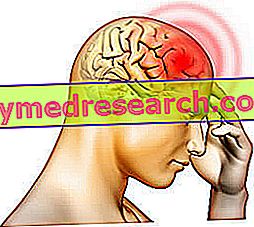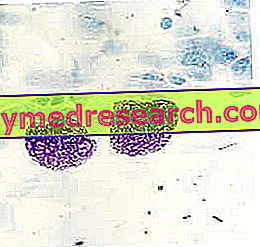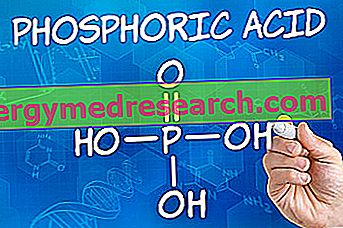Generality
Hepatic encephalopathy is a type of encephalopathy that affects individuals with liver failure. In fact, these patients have a liver incapable of eliminating waste substances from the blood, the accumulation of which leads to a deterioration of the nerve cells.

The treatments vary depending on the severity of the triggering causes: for example, an acute hepatic encephalopathy requires the realization (among other things in limited time) of a liver transplant.
Brief reminder of encephalopathies
Encephalopathies represent a group of neurological diseases that determine, after structural changes of the brain, a distinctive alteration of the mental state.
Congenital or acquired, an encephalopathy can last a lifetime ( permanent encephalopathy ) or may have a more or less considerable margin of healing ( temporary encephalopathy ).
The various types of encephalopathy differ from each other due to the triggering causes - to which they usually owe their names - for the symptoms, for the complications, for the treatment and for the prognosis.
In general, individuals with encephalopathy develop memory disorders (especially amnesia), depression, personality changes, inability to solve simple problems of daily life, lethargy, myoclonus, tremors, etc.
List of some encephalopathies:
- Chronic traumatic encephalopathy
- Hashimoto encephalopathy
- Glycine encephalopathy
- Diabetic encephalopathy
- Wernicke's encephalopathy
- Hypoxic encephalopathy
- Hypertensive encephalopathy
- Transmissible spongiform encephalopathy
What is hepatic encephalopathy?
Hepatic encephalopathy is a type of encephalopathy that occurs due to a serious pathological condition known as liver failure .
Therefore, to determine the appearance of this particular neurological disease is the presence of a seriously ill and no longer functional liver.
WHAT IS HEPATIC DEFICIENCY AND HOW DO YOU AFFECT IT?

Among the latter, they fall:
- Production of essential proteins and hormones
- The production of coagulation factors, to stop blood loss
- The regulation of cholesterol levels in the blood
- The "cleansing" of blood, from toxins and infectious agents
- Supply the body with energy when it is in deficit
The decisive factor in the onset of hepatic encephalopathy is the failure to clean blood from waste substances and infectious agents . In the long run, in fact, these unwanted presences increase significantly and this causes the progressive deterioration of the nerve cells located in the brain.
Exemplifying, it is as if in a city suddenly the services of urban garbage were terminated: the accumulation of garbage that follows entails a bad smell, spread of diseases and so on.
IS IT TEMPORARY OR PERMANENT?
Hepatic encephalopathy can be temporary, permanent or even fatal, depending on the triggering conditions.
In general, the rule based on which the more serious the causes are, the more the disease has lasting consequences or even fatal.
Causes
According to the causes that cause the liver, doctors have recognized the existence of two types of hepatic encephalopathy: an acute form (or type A) and a chronic form (or type C).
ACUTE HEPATIC ENCEPHALOPATHY
With sudden onset and very rapid progression, acute hepatic encephalopathy is the result of a severe liver disease with an equally acute character .
According to the Canadian Liver Foundation report, the main morbid conditions that accompany acute hepatic encephalopathy are:
- Acute fulminant viral hepatitis . It is a very dangerous viral hepatitis, which determines its effects very quickly.
- Toxic hepatitis . It is a form of hepatitis that occurs after exposure to certain substances, including alcohol, drugs, particular chemicals, etc.
- Reye's syndrome . It is a serious condition that affects children and causes inflammation of the liver and cerebral edema.
Acute hepatic encephalopathies are potentially lethal conditions.
CHRONIC HEPATIC ENCEPHALOPATHY
Chronic hepatic encephalopathy is usually associated with liver cirrhosis .

Unlike the acute version, chronic hepatic encephalopathy is established more slowly and more subtly. Furthermore, it could be temporary (or episodic), persistent (or permanent) or minimal (ie causing very mild symptoms).
FAVORABLE FACTORS
Although they still do not have precise scientific evidence on the matter, doctors and researchers believe that the appearance of hepatic encephalopathy is favored by some particular factors and situations.
Remembering that at the base there must still be a serious affection of the liver, such factors and situations are:
- A nitrogen overload that leads to increased levels of ammonia in the blood . For example, it occurs: when taking too many proteins; in the presence of severe kidney problems; due to gastrointestinal bleeding; following a state of prolonged constipation; etc.
- State of dehydration
- Presence of electrolytic or metabolic imbalances of various nature . For example, hyponatremia (low blood sodium levels), hypokalaemia (low levels of potassium in the blood) or alkalosis (excess bases in body fluids) are dangerous.
- Improper intake of benzodiazepines (sedative drugs), narcotics (pain medications) and antipsychotics .
- Alcohol poisoning
- Hypoxia, or low levels of oxygen in body tissues
- Infections of various types, such as pneumonia, urinary tract infections, spontaneous bacterial peritonitis, etc.
- Certain medical procedures, both surgical and interventional radiology . In particular, we note the transjugular intrahepatic portosystemic shunt operation (TIPS), aimed at the treatment of portal hypertension and its complications (esophageal varices and ascites). Through this interventional radiology technique the operating physician connects the portal vein with the hepatic vein, effectively creating an artificial channel between the two vessels.
According to the most recent research, 25-30% of TIPS would result in the appearance of a temporary form of hepatic encephalopathy.
Important note
The transjugular intrahepatic portosystemic shunt procedure can cause hepatic encephalopathy even in the absence of severe liver disease.
Faced with this possibility and the enormous number of cases resulting from TIPS, the doctors participating in the 1998 World Congress of Gastroenterology (Vienna) believed that it was appropriate to recognize the existence of a third type of hepatic encephalopathy: the so-called type B ( the letter B stands for "bypass" and refers to the construction of the artificial canal between the portal vein and the hepatic vein).
PATHOGENESIS: WHAT DO THEY CONTAIN THE WASTE NOT ELIMINATED?
The pathogenesis is quite complex and, for its understanding, some notions of neurobiology are required which would be too long to discuss here.
In simple terms, in the waste substances not eliminated by the liver there are numerous nitrogen-based molecules - ammonia in particular - which alter the structure of nerve cells and brain signaling mechanisms.
All this, therefore, affects the normal brain functions and determines the progressive establishment of the disease.
Epidemiology
According to some statistical surveys, hepatic encephalopathy would affect 30-45% of people with liver cirrhosis. This means that out of 1, 000 cirrhotic persons, about 300-450 suffer from hepatic encephalopathy.
The subjects most affected are between 50 and 60 years old; however, it must be specified that the disease can occur at any age.
Both sexes are equally involved and all races are equally at risk.
Symptoms and Complications
Like any other encephalopathy, also the hepatic one causes alterations of the mental state, of the state of consciousness and behavior.
The typical symptoms and signs of such alterations are numerous and vary according to the severity of the disease, which means: the more hepatic encephalopathy is in an advanced stage, the more serious the symptoms are.
STAGES OR DEGREES OF THE DISEASE
To simplify the consultation of the symptomatic picture, doctors and experts have assigned to the pathology four stages or degrees ( West Haven criteria ):
- At stage 1, the patient experiences a slight lack of attention, moderate confusion, loss of awareness, nightmares, sleep disturbances resulting in daytime sleepiness, restlessness, anxiety, irritability, depression and / or anxiety.
- At stage 2, the patient manifests personality changes, a worsening of sleepiness, an inability to resolve even trivial mental calculations, amnesia, a slowing response to stimuli, episodes of disobedience, gloom and / or disorientation over time and space.
For the sick at this stage of the disease, there is also talk of lethargy and apathy.
- At stage 3, the patient experiences sudden and unjustified anger, severe mental confusion, bizarre behavior, use of incomprehensible language, paranoia, high sleepiness and / or persistent irritability.
In this phase of the disease, the physical examination reveals the presence of myoclonus (that is involuntary tics of one or more muscles) and of the Babinski sign (that is an anomalous movement of the big toe triggered by a particular stimulation at the level of the plant of foot).
- At stage 4, the patient enters a coma and no longer shows any response to any external stimulus.
OTHER POSSIBLE SIGNS OF THE DISEASE
Having the liver diseased, very often patients with hepatic encephalopathy also show typical signs of severe liver disease, therefore: ascites (collection of fluid in the peritoneal cavity), jaundice (is a response to elevated levels of bilirubin in the blood), peripheral edema ( generally to the legs) and fetor hepaticus (breath with the sweet smell).
Diagnosis
To diagnose hepatic encephalopathy, doctors base their investigations on two equally important aspects:
- Detection and observation of neurological disorders e
- The presence of a liver disease or a previous portosystemic shunt .
Once these two points have been clarified, they pass to the exclusion of similar conditions from the symptomatological point of view, such as for example cerebral hemorrhage or epilepsy.
This approach - also called differential diagnosis - involves performing a brain CT scan (for bleeding) and an electroencephalogram (for epilepsy).
TAC LIMITS AND EEG
Other diseases with symptoms similar to hepatic encephalopathy:
- Meningitis
- Encephalitis
- Wernicke's encephalopathy
- Wilson disease
Although CT and electroencephalogram (EEG) are essential to rule out the presence of cerebral hemorrhage or epilepsy, their execution is not sufficient to decree the status of hepatic encephalopathy.
The reasons are different:
- First of all, the brain CT scan does not show any particular anomaly unless the patient is in a coma, in other words when the disease has already irreparably compromised the health of the patient.
- Secondly, the EEG does not distinguish brain activity abnormalities induced by hepatic encephalopathy from those induced by other similar neurological diseases.
Therefore it is useful for the purposes of differential diagnosis, but not for the purpose of a specific diagnosis of the current disease.
BLOOD TESTS AND OTHER TESTS
The collection and analysis of a blood sample can provide information that is quite valid for diagnostic purposes, as it is able to detect a possible presence of hyperammonemia .
Hyperammonemia - that is, high presence of ammonia in the blood - is a clinical sign that characterizes about 90% of patients with hepatic encephalopathy and derives from reduced liver function.
Other useful tests:
- Urine analysis
- Chest X-ray
- Diagnostic paracentesis (in case of ascites)
Treatment
To plan the most appropriate treatment, doctors must first of all go back to the precise type of hepatic encephalopathy in place (so to understand if it is an acute, chronic or portosystemic shunt ); therefore they must identify the favoring factors and immediately remedy them.
Exemplifying, this means that if a contributing cause is dehydration, the patient must be rehydrated in a timely and appropriate manner; if it is the use of benzodiazepines, you must stop taking these drugs immediately; if it is a diet rich in proteins, it is necessary to radically change the type of diet etc.
Once these first two steps have been completed, the need to correct the diet and administer certain drugs comes into play.
TREATMENT AND TYPE OF LIVER ENCEPHALOPATHY
Type A hepatic encephalopathies, or acute, require (or, better, would require) an immediate liver transplant, as the evolution of liver disease is rapid and fatal.
Type C liver, or chronic encephalopathies, allow more time than the previous ones, but still require a liver transplant, since the patient's liver health is definitively compromised.

A diet rich in fiber favors intestinal transit and the growth of probiotic species, to the complete disadvantage of the putrefactive flora. All of this translates into less production and less nitrogen absorption, which is particularly useful in the presence of hepatic encephalopathy.
Finally, type B hepatic encephalopathies, not connected to a severe liver disease (NB: this point is fundamental), are almost always solved spontaneously.
DIET
The dietary advice that a person with hepatic encephalopathy should follow consists of:
- Avoid protein-rich meals .
By increasing nitrogen levels (ammonia in particular), protein-rich meals would worsen the situation.
The proteins present in the diet must be normal (normoproteic diet) and of high quality for the maintenance of muscle mass. Eventually the diet can be enriched with a supplement of branched amino acids.
- Eat lots of vegetables and foods that are high in fiber .
Vegetables and fiber-rich foods speed up the passage of ingested food into the digestive tract. This means that the absorption of some molecules, including those based on nitrogen such as ammonia, is reduced.
DRUGS: LACTULOSE AND ANTIBIOTICS
The drugs administered are lactulose and antibiotics .
Lactulose is an indigestible sugar of synthetic origin, which is administered by mouth in order to reduce the pH of the colon and favor the conversion of ammonia into ammonium ion.
In fact, ammonium ion is less dangerous than ammonia.
Antibiotic treatment - usually consisting of neomycin, metronidazole and rifaximin - serves to limit the growth of ammonia-producing bacteria, normally present in the human digestive system. For the same purpose, the intake of probiotic milk enzymes may also be useful.
Prognosis
Acute hepatic encephalopathy has an almost always negative prognosis, unless the liver transplant is performed in a short time.
Chronic hepatic encephalopathy and type B encephalopathy, on the other hand, are curable, even with satisfactory results.



